This pine needle soda is a delicious and quick naturally fermented drink made with foraged ingredients. Pine needles have a citrusy, pine, and minty flavor. Some people call this pine needle sprite because it’s fizzy and has a similar flavor, but it is made with all-natural ingredients!
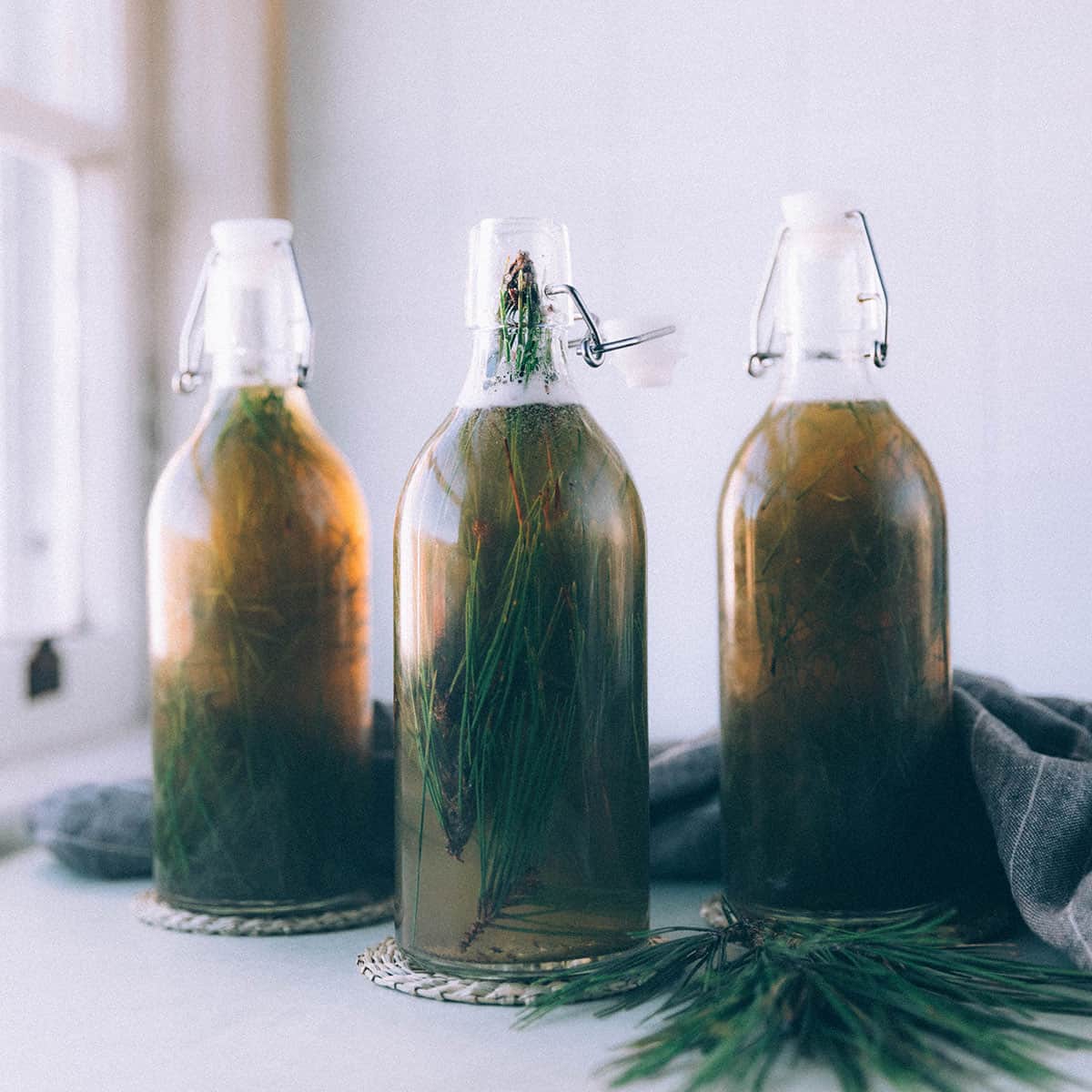
Want to save this post for later?
What Type of Needles to Use
For this quick fermented pine needle soda, you can use any edible conifer needles. Pine, fir, or spruce are all okay to consume and are popular choices.
Foraging for pine needles is a lovely way to spend a winter afternoon!
It’s important to properly identify the conifer needles you are using, as some are toxic such as the Yew family.
Pine and other conifer needles have natural yeasts on them that cause fermentation to happen when water and some kind of sweetener are added, like sugar or honey.
During fermentation, the yeast on the pine needles eats the sugar and outputs bubbles, making for a fizzy drink! This is a super fun winter project to make, and it only takes about 3 days to ferment.
Related: 30+ Pine Needle Recipes, 12 Fermented Soda Recipes
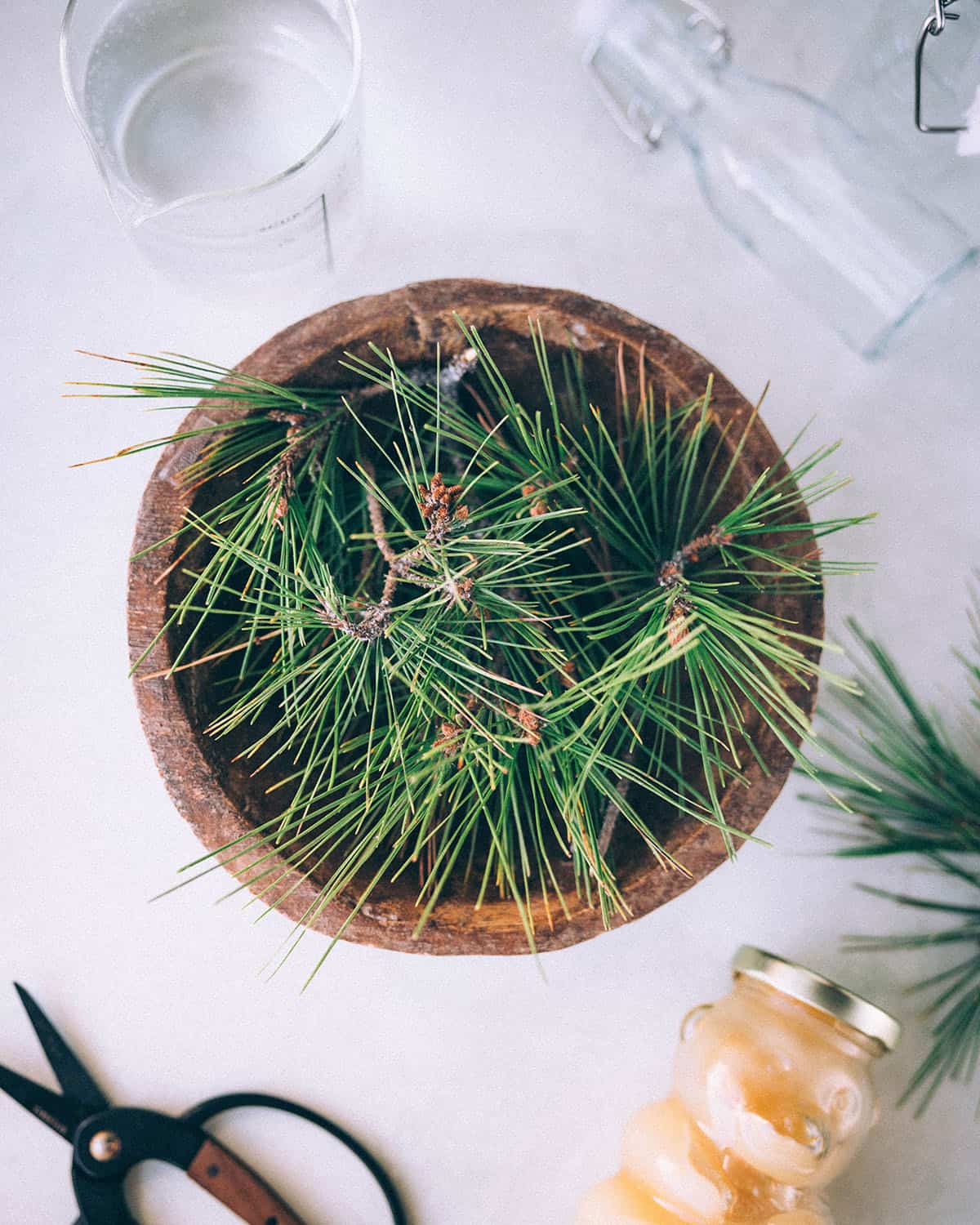
Pine Needle Soda Benefits
Pine needles have tons of benefits, namely their high vitamin C content. Drinking fermented pine needle soda has more vitamin C than a glass of orange juice!
With immune boosting qualities of vitamin C, pine needles also provide a boost of vitamin A. Pine and other conifer needles have antibacterial and pain relieving properties too.
Medicinally, pine needles are an expectorant for coughs and can help relieve chest congestion. Along with this fermented soda’s refreshing taste, any time you drink it there are health benefits!
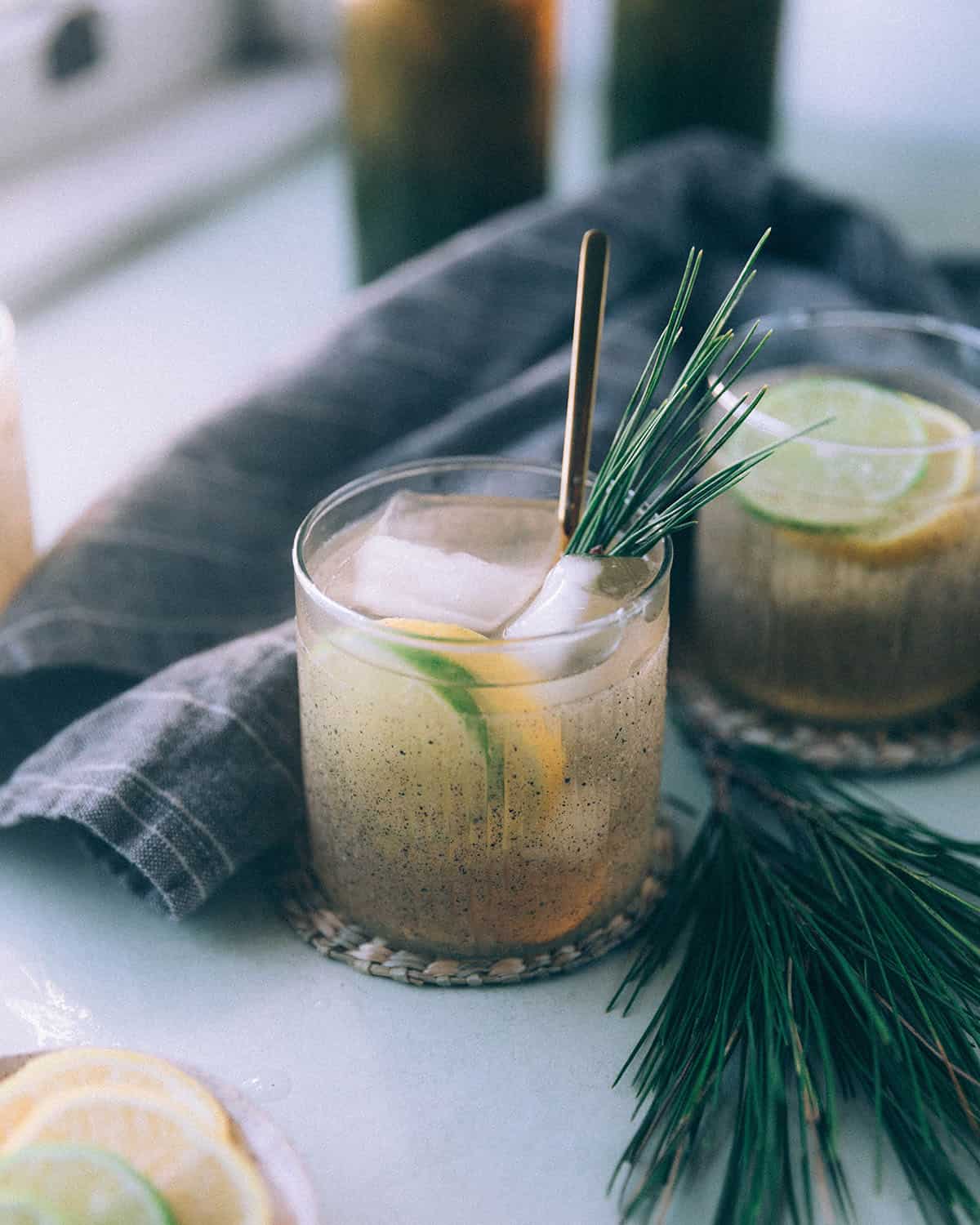
For health benefits from other natural fermented sodas, try my turmeric soda, yarrow and rose soda, strawberry rhubarb soda, and even fermented root beer!
Is Pine Needle Soda Alcoholic?
This fermented soda has a negligible amount of alcohol and is considered to be non-alcoholic. That said, everything that is fermented has some amount of alcohol, so keep that in mind.
Since it is a quick ferment with a low amount of sugar, pine needle soda will not produce much alcohol at all. However, if you were to ferment it longer and with more sugar, then it could become more like a pine needle beer, similar to my spruce beer recipe.
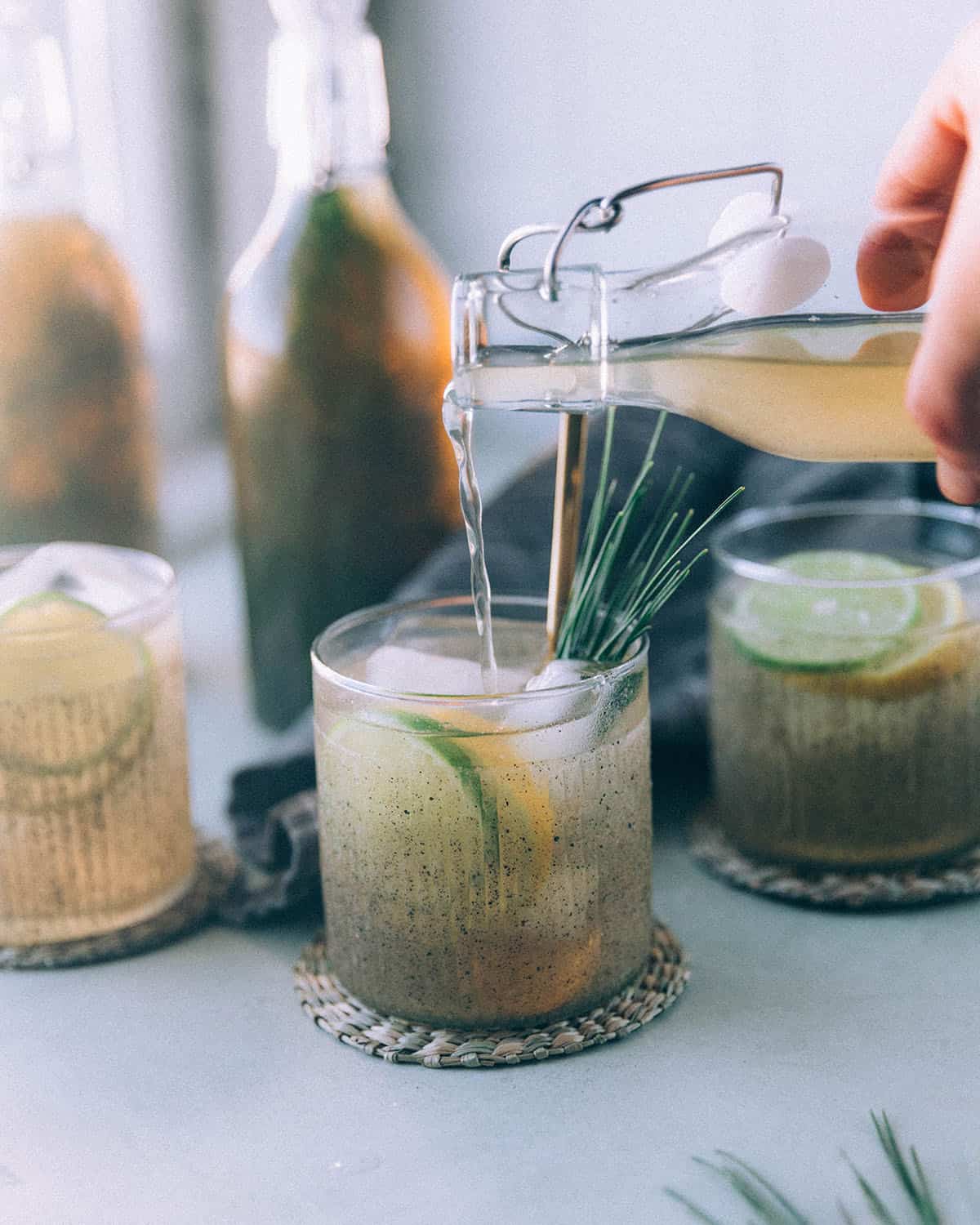
Pine Needle Soda Recipe
First, let’s talk about sugar because I know many of you are wondering! The sweetener in this recipe needs to have some kind of sugar in it, so honey, maple syrup, sugar, brown sugar, will all work.
However, sugar substitutes like stevia, erythritol, monk fruit, etc… will likely not work. The bacteria that do the fermentation need to “eat” real sugar, and then they produce bubbles making a lovely fizzy drink!
Ingredients
Pine needles: Whole pine needle bundles with a small bit of the branch still intact seemed to ferment better and quicker than cut pine needles, but feel free to experiment and see what works best for you.
Filtered water: Use filtered water or bottled water to be sure that it doesn’t have anything in it that will disrupt the fermentation process.
Honey: Use raw honey or substitute it with other real sugar, such as brown sugar, maple syrup, or organic sugar.
Optional garnish: Lemon, lime, or orange slices.
How to Make Pine Needle Soda
Once you identify and forage edible pine or other conifer needles, gently rinse them in cool water if they are dirty.
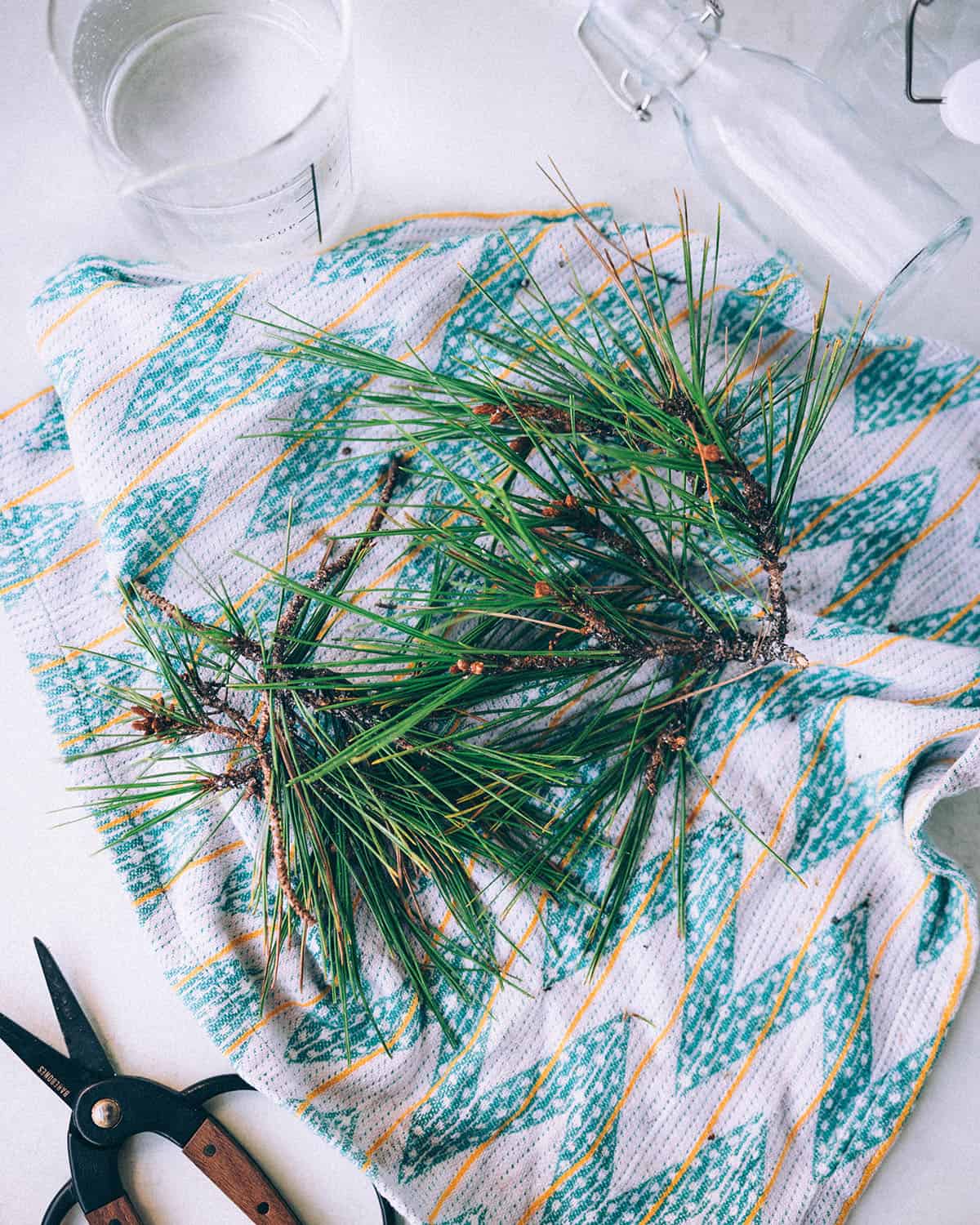
Put the pine needles into a 16 ounce flip top bottle.
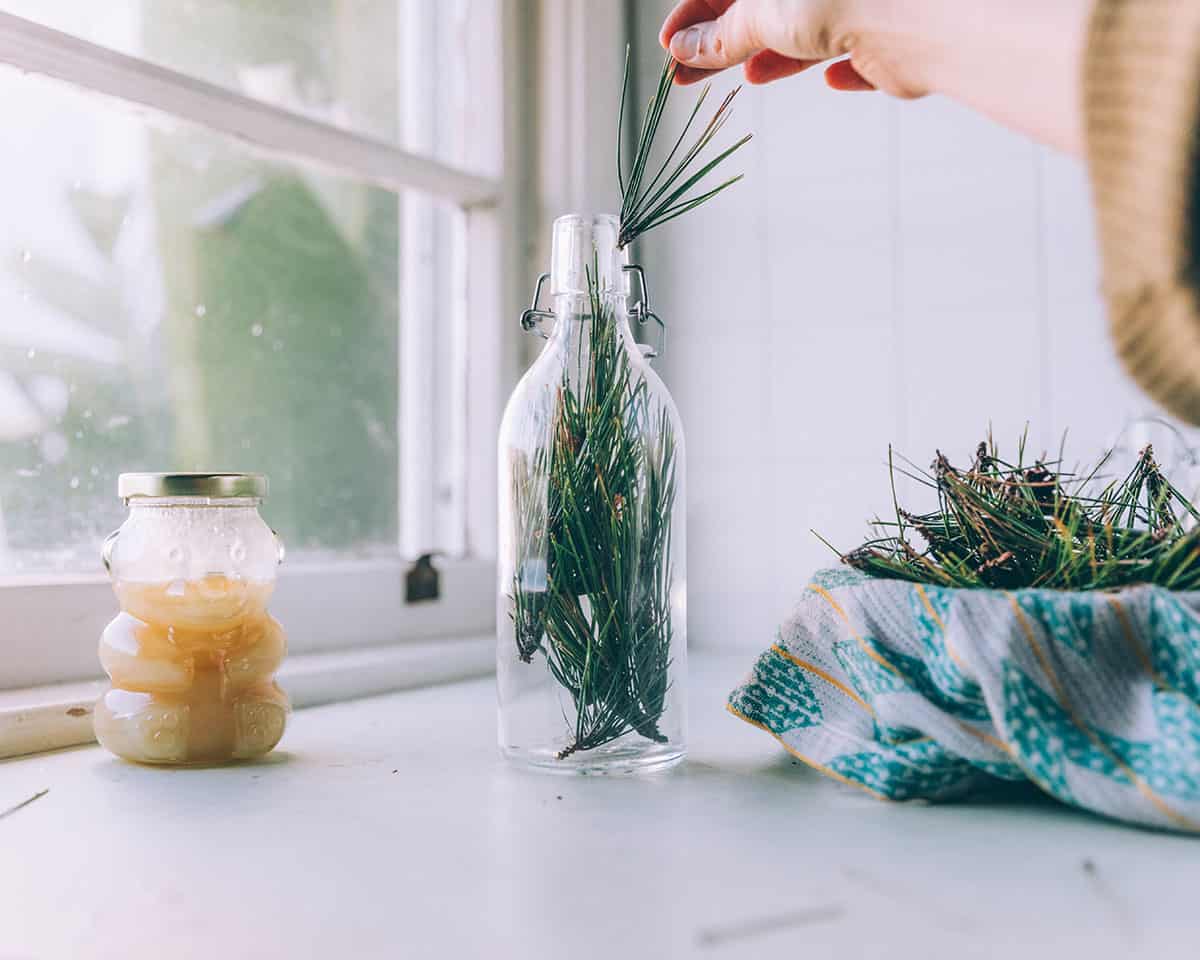
Now add the honey to the bottle over the pine needles.
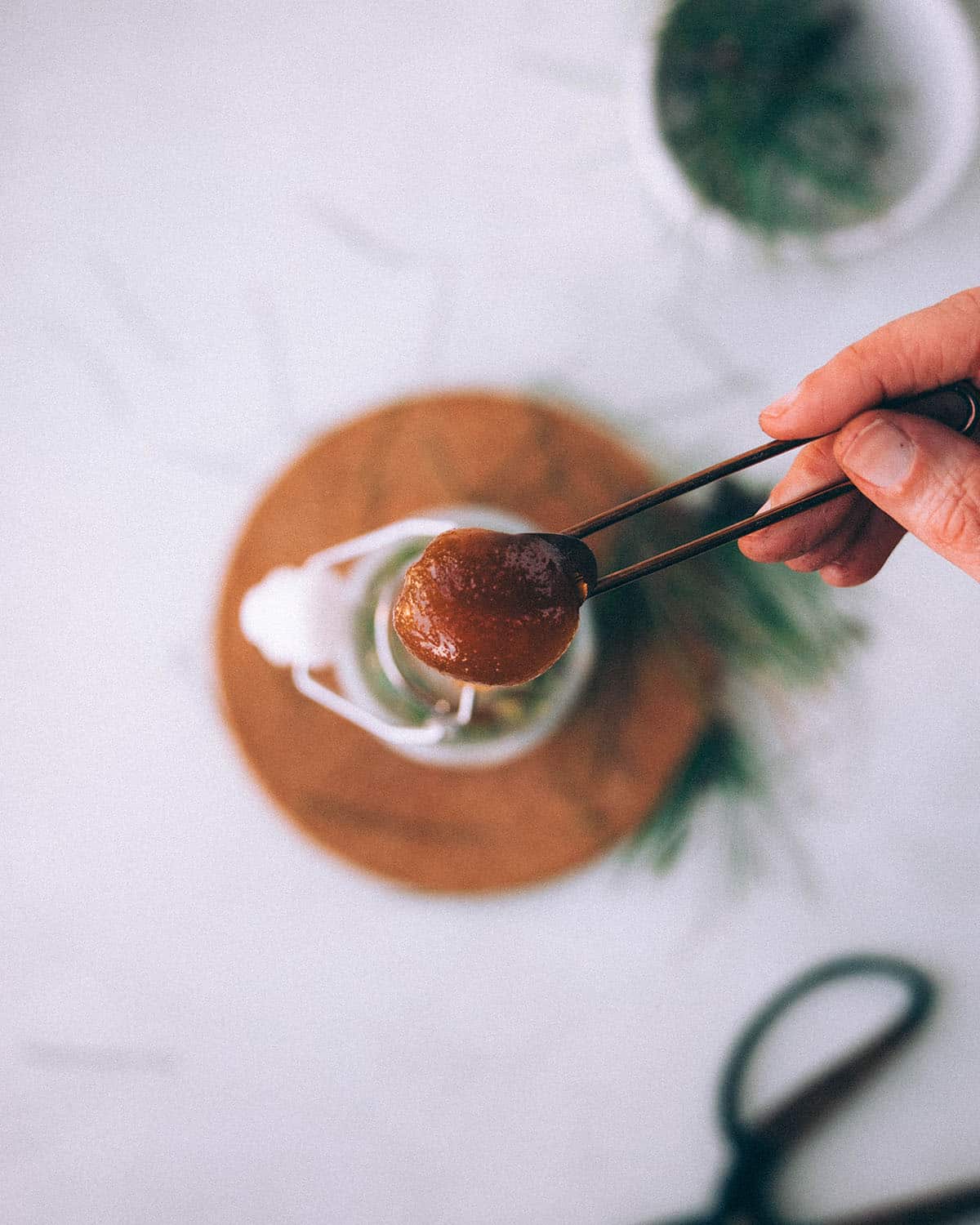
Then pour filtered water into the bottle. It helps to use a small funnel.
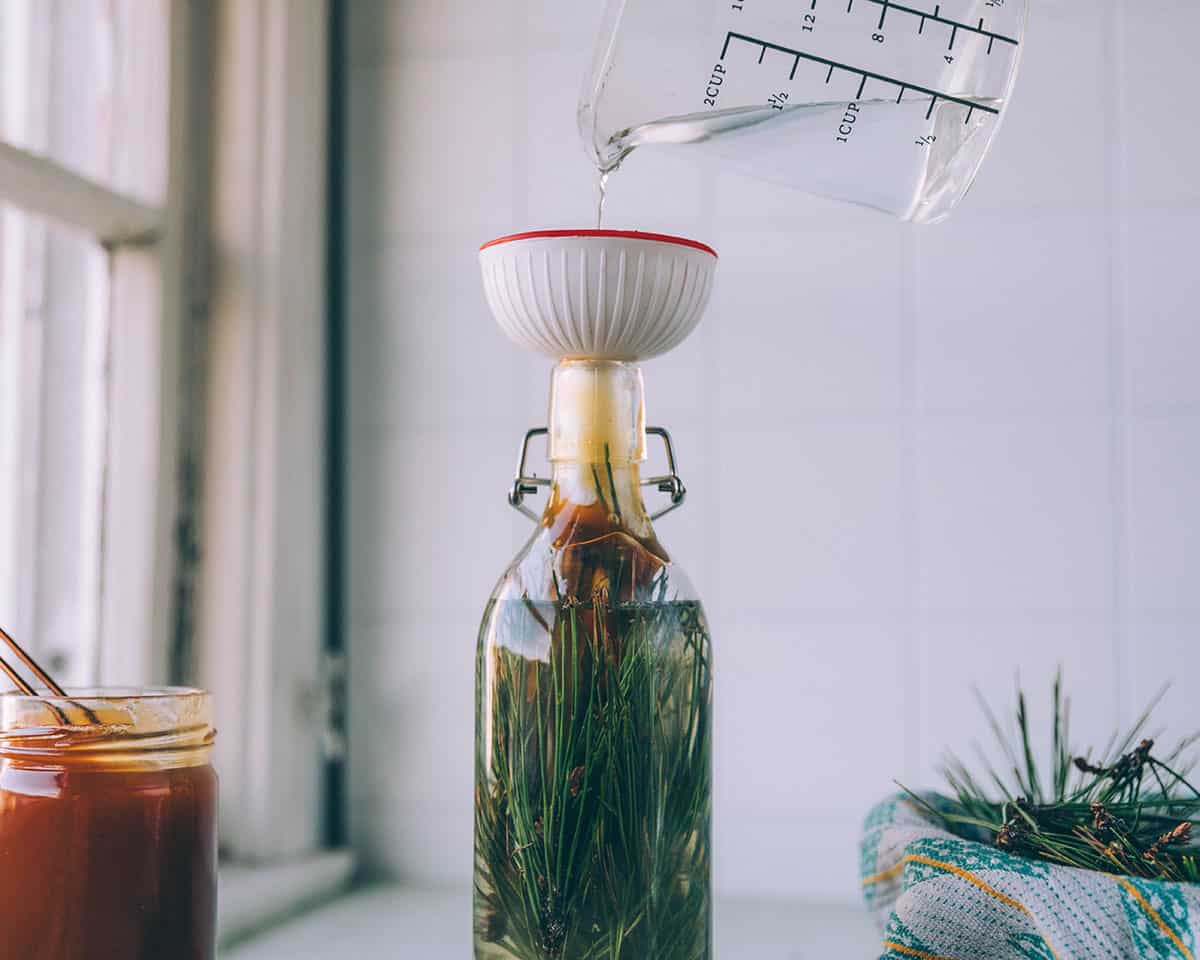
Make sure to leave 1-2 inches of headspace at the top so there is room for air bubbles during fermentation.
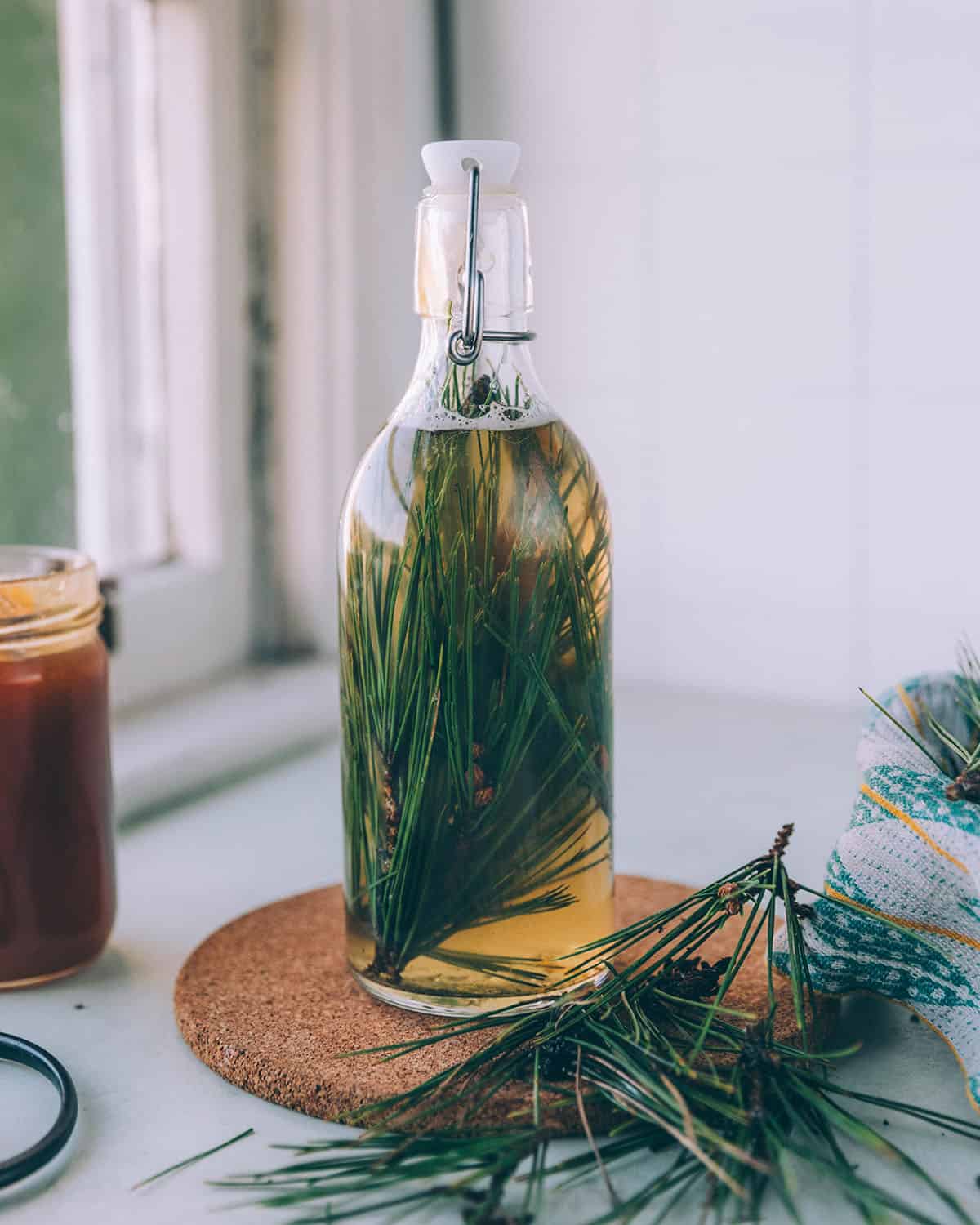
Close the lid and shake the bottle a little bit to distribute the honey since it needs to mix with the yeast on the pine needles for the pine needle soda to ferment.
Put the bottle in a warm (not too hot or too cold) place to ferment. A kitchen counter usually works great!
The soda should start fermenting and producing carbonation after 2-3 days. Be careful when opening the bottle as it could have a lot of bubbles!
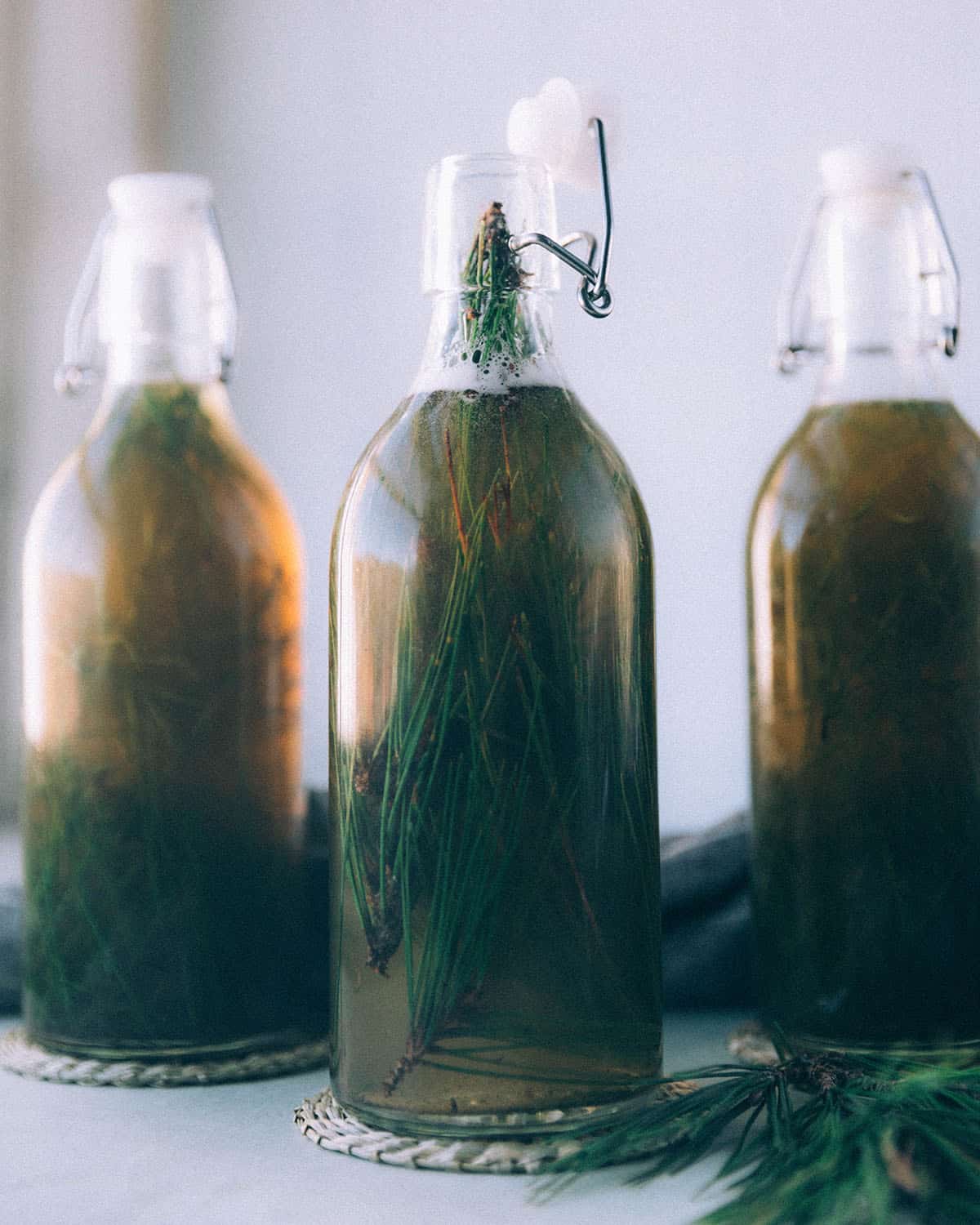
Don’t let the bottles sit longer than 3 days without opening so that the pressure doesn’t build up too much. You don’t want the bottle to burst!
Note: Burping the bottles is not necessary unless you want to ferment the soda for longer than 3 days. If so, burp after 3 days and let it continue to ferment.
Lastly, strain the soda with a fine mesh sieve before serving.
How Serve and Keep
This is a fun foraging and fermentation project to make in the winter! To drink pine needle soda, serve over ice with a lemon, lime or orange slice for garnish.
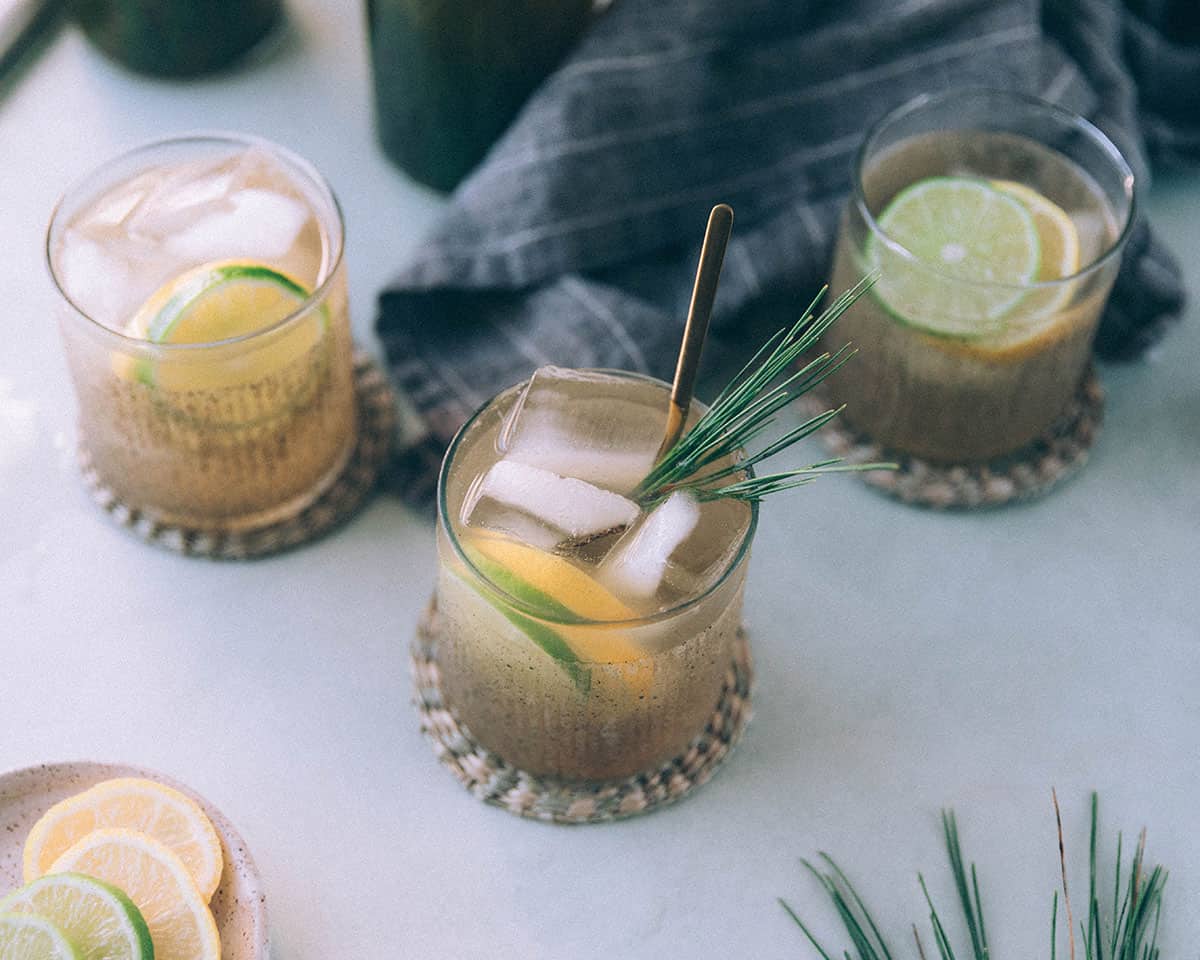
It’s also known as pine needle sprite because the flavor is similar! It’s light, bright, fragrant and very refreshing. The pine flavor is there but isn’t overwhelming. This is my new favorite soda!
Once your pine needle soda is ready to drink, it can be stored in the refrigerator until it has all been enjoyed. Cheers to natural fermentation!
More Pine Needle Recipes
- Pine Needle Infused Honey
- Pine Needle Cough Syrup
- Pine Needle Tea
- Pine Needle Cookies
- Pine Lotion Bars for Winter
- Winter Spice Pine Soap Recipe
- Conifer Infused Body Oil
- Rosemary Pine Beard Balm
- Pine Salve With Infused Pine Oil
- Conifer Tip Syrup
Pine Needle Soda
Ingredients
- 1 cup pine needles
- 1 ½ cup filtered water
- 2 tablespoons raw honey or sugar
- lemon, lime, or orange slices optional for garnish
Instructions
- If the pine needles are dirty, gently rinse them in cool water.
- Put the pine needles into a 16 ounce flip top bottle.
- Add the honey and filtered water to the bottle using a small funnel if necessary. Leave 1-2 inches of headspace at the top.
- Close the lid and shake the bottle a bit to distribute the honey.
- Put the bottle in a warm (not too hot or too cold) place to ferment – a kitchen counter usually works great.
- The soda should start fermenting and producing carbonation after 2-3 days. Be careful opening the bottle as it could have a lot of bubbles! Don’t let the bottles sit longer than 3 days without opening so that the pressure doesn’t build up too much.
- Strain the soda with a fine mesh sieve and serve over ice with a lemon, lime or orange slice for garnish.
Notes
- Any edible conifer needles such as pine, fir, or spruce can be used for making this soda.
- Be sure to properly identify the tree before using. Yew trees are highly toxic and should not be used.
- Whole pine needle bundles with a small bit of the branch still intact seemed to ferment better and quicker than cut pine needles, but feel free to experiment and see what works best for you.
- Burping the bottles is not necessary unless you want to ferment them longer than 3 days – if so, I would burp after 3 days.
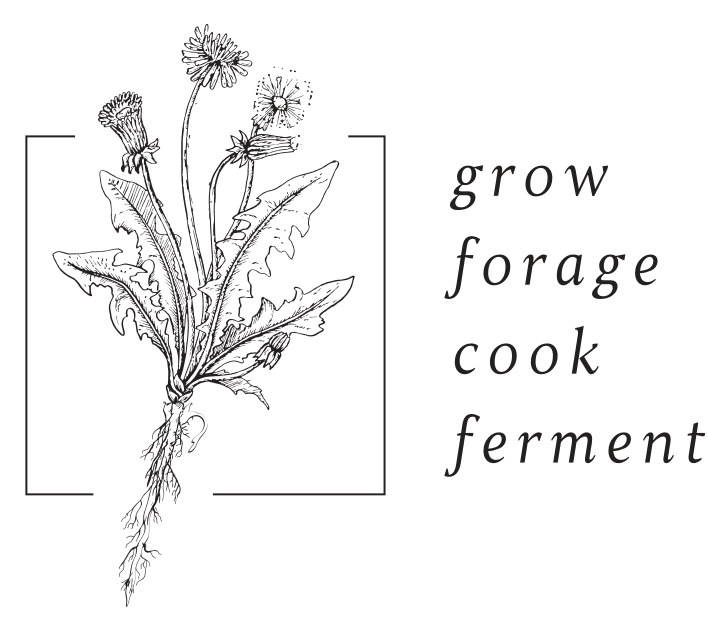
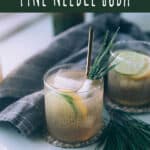


Will juniper work for this recipe?
Hi Bonnie. I have not tried using juniper to make this fermented soda, so I can’t say how it’s taste. As long as you know you have an edible juniper species, you could try it and let me know!
Isn’t botulism a concern
No. Botulinum thrives in low-acid environments. This pine needle soda is made with lemon (high in acid), raw honey (antimicrobial) and the fermentation time is only a few days, which is not long enough for botulism to result.
Is there a calculation for how much % of alcohol it’ll be in how many days extra fermentation?
No, I only fermented it for a couple of days and it had a negligible amount of alcohol.
I brew beer. Do the math, but to every lb of sugar you add to 5 gallons of water results in ~1% alcohol. When I brew I use between 5-8#s of malt (sugar) extract, resulting in 5-8% alcohol beer.
can I use cheese cloth to strain with instead of a fine-mesh sieve? thanks!
Yes, that should work great!
Hi!Thnak you for you beatiful work – sharing these information, experieces and recipes is very much appreciated!
A question, though: aren’t the antibacterial propreties of honey conterproductive in a fermentation?
Where this recipe cames from?
Woulnd’t be better brown suger or other kind of sugar (syrups, etc)?
Thank you,
Giulia
You can use brown sugar, if you prefer. No, the antibacterial properties are not counterproductive to fermentation. When water is added to honey, it dilutes the sugar content (which makes honey antibacterial) and allows yeast and bacteria to grow (ferment).
I definitly want to try this. Checked other sites as well….seems the concensus is that once you open it, it lasts 2 or 3 days in the fridge but if you don’t open it, it can last several months… But seems to me you always open it to burp* the bottle after 3 days. So what do they mean, if it’s unopened it will last for months?
Thank you!
*resubmitted since original had typo “burn the bottle”
I’m really not sure what those other recipes mean. The pressure will build up too much in the bottle if it was never opened. And the point is to drink it, right?
One of my bottles exploded after 4 days!
Oh, no! I’m sorry to hear that. Did you use a fliptop bottle made for fermentation?
amazing
simple, yummy, should be in a restaurant, and is great with orange juice in my opinion. oh also morchella esuclenta is a yellow morel
I tried this recipe using honey as the sugar source but I ended up with a slightly yellow solution that tasted like a strong vinegar. Nut sure what I did wrong
Hi – I can’t see my question from yesterday about how long it will keep in the fridge?
I made this on the 12th Jan, it took a week to get fizzy. Then I put it in the fridge. I drank some on Thursday 1st Feb and was really sick on Friday 2nd Feb.
Unless your soda had mold, you’re allergic to pine needles, or you used toxic conifer needles like yew, the pine needle soda likely wasn’t the reason you were sick.
I made this with q homeschool group. On the 3rd day we opened it. It only tastes like sugar water. What did we do wrong?
Maybe not enough pine needles? Were they old? Species of pine have unique flavors, so it could just be the type you used. You also should use young, fresh needles for this recipe.
I’m having trouble with mine too and I think my filter isn’t great. It could be my heavy tap water didn’t filter well. But also I got my recipe from another site and we’ve been burping it and leaving it in the winter window. I’ll move it and leave it closed a couple days. But I imagine you didn’t use filtered water at a school? Or the temp there is very cold so you needed a couple more days. Did it look bubbly before you opened them?
If I have an allergic reaction to pine when I touch it fits that mean I would have a reaction if I consumed it?
I’d assume so.
Will bottled spring water work?
Distilled water won’t work, correct?
The gases won’t continue to build up once filtered so no chance of a bottle exploding then I assume?
Sorry for so many questions!
Really looking forward to making the pine and ginger ferments!
I would use spring water. I refrigerate after it ferments and haven’t had any bottles explode.
Can you use a normal Mason jar? Instead of a flip top?
Yup.
When you say use filtered water, do you mean through a brita filter or something similar? What’s the point of this step?
Yes, any filtered water will work. Tap water may contain chemicals that could inhibit fermentation, which is why it’s best to use filtered water.
I’m excited to try. I’m going to forage right off my Christmas tree.
I know your post is old but I just wanted to comment. Christmas tree farms spray their trees with chemicals to prevent pests, fungus and mold. Please don’t consume commercially grown Christmas trees if you don’t know where they’re coming from and what their practices are. These chemicals aren’t meant to be consumed and they’re perfectly legal to use because the product isn’t intended for consumption. Best bet would be to go find some wild pine away from busy streets.
I made this a few days ago as an ‘experiment’ and I am so delighted with the outcome. I made it with white pine, and sugar in a mason jar since that is what I had on hand. The mason jar made it easy to remove the needles afterward before straining it with cheesecloth.
I am looking forward to trying it with honey and other types of evergreens. I was reading up on the different flavor properties of each. I was thinking this might be great to make a mocktail version of your recent cranberry champagne cocktail.
I’m so glad you enjoyed this recipe, Susan! I’m looking forward to hearing how your mocktail comes out!
How much honey would you recommend? A tablespoon? More? Less?
Thanks!
The recipe calls for 2 tablespoons, so I would go with that.
Is there any alcohol in this type of ferment? I need to be very careful not to consume alcohol even in tinctures or suppliments and can’t drink kombucha, or kefirs due to an alcohol allergy or sensitivity. I get a horrible reaction if even a little is in anything.
Three days of fermentation will produce a negligible amount, but if your reaction is that bad, I would probably not make this recipe.
Is there a reason for using this style of glass bottle?
And if it is important how do you get the pine needles back out so you can reuse the bottle please? X
You’ll need to use a bottle that’s built to withstand the pressure of gas building up inside of it. I hold the bottle upside down and pull the pine needles out with a chopstick.
Will it work if I use screw-top bottles instead of flip top?
Yes, but you’ll want to be sure to use a bottle that was made for fermentation and can withstand gases being built up inside it, otherwise, there’s a chance it could explode.
Would canning jars work?
Also, can this be done with other herbs? Is this a recipe that can be subbed out for any herb?
Yes, you can use a canning jar. I haven’t tried with any other herbs, but as long as they still have natural yeast on them, they should ferment.
How do you get the pine needles out after the soda is gone?
I use a chopstick to slide them out of the bottle.